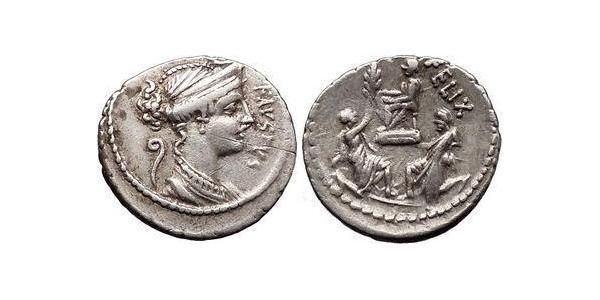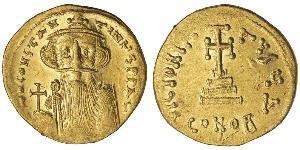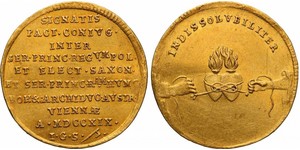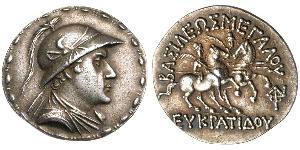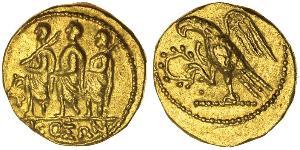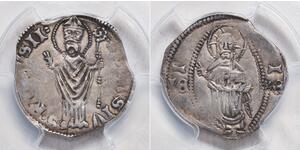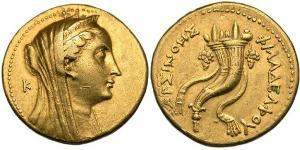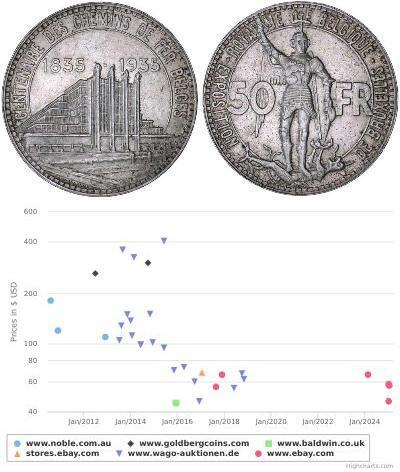[ 4188] Faustus Cornelius Sulla Silver Denarius (20mm, 3.61 gm.), 56 B.C. Rare Reference: RRC 426/1. CRR 879. RSC Cornelia 59. RRM 16.1-2. Diademed and draped bust of Diana right, crescent above, lituus behind, FAVSTVS before. Sulla seated left between King Bocchus of Mauretania, who kneels right before him, presenting olive-branch, and King Jugurtha of Numidia, who kneels left behind, his hands bound, FELIX on right. Faustus was the son of L.Cornelius Sulla. The remarkable reverse type reproduces the device engraved on the dictator's signet ring which commemorated the pivotal event in his early career-the betrayal of Jugurtha by his father-in-law Bocchus at Sulla's instigation. Harlan dates the issues of Faustus as moneyer to 55BC and those struck ex senatus consulto to the following year Provided with certificate of authenticity. CERTIFIED AUTHENTIC by Sergey Nechayev, PhD - Numismatic Expert Lucius Cornelius Sulla Felix (Latin: L•CORNELIVS•L•F•P•N•SVLLA•FELIX) (c. 138 BC – 78 BC), known simply as Sulla, was a Roman general and politician, having the rare distinction of holding the office of consul twice as well as the dictatorship. He was one of the canonical great men of Roman history; included in the biographical collections of leading generals and politicians, originating in the biographical compendium of famous Romans, published by Marcus Terentius Varro. In Plutarch's Sulla, in the famous series - Parallel Lives, Sulla is paired with the Spartan general and strategist Lysander. Sulla's dictatorship came during a high point in the struggle between optimates and populares, the former seeking to maintain the power of the oligarchy in the form of the Senate while the latter resorted in many cases to naked populism, culminating in Caesar's dictatorship. Sulla was a highly original, gifted and skillful general, never losing a battle; he remains the only man in history to have attacked and occupied both Athens and Rome. His rival, Gnaeus Papirius Carbo, described Sulla as having the cunning of a fox and the courage of a lion - but that it was the former attribute that was by far the most dangerous. This mixture was later referred to by Machiavelli in his description of the ideal characteristics of a ruler.[2] Sulla used his armies to march on Rome twice, and after the second he revived the office of dictator, which had not been used since the Second Punic War over a century before. He used his powers to enact a series of reforms to the Roman constitution, meant to restore the balance of power between the Senate and the Tribunes; he then stunned the Roman World (and posterity) by resigning the dictatorship, restoring normal constitutional government, and after his second Consulship, retiring to private life. The Roman Republic was the phase of the ancient Roman civilisation characterised by a republican form of government. It began with the overthrow of the Roman monarchy, c. 509 BC, and lasted over 450 years until its subversion, through a series of civil wars, into the Principate form of government and the Imperial period. The Roman Republic was governed by a complex constitution, which centred on the principles of a separation of powers and checks and balances. The evolution of the constitution was heavily influenced by the struggle between the aristocracy (the patricians), and other talented Romans who were not from famous families, the plebeians. Early in its history, the republic was controlled by an aristocracy of individuals who could trace their ancestry back to the early history of the kingdom. Over time, the laws that allowed these individuals to dominate the government were repealed, and the result was the emergence of a new aristocracy which depended on the structure of society, rather than the law, to maintain its dominance. During the first two centuries, the Republic saw its territory expand from central Italy to the entire Mediterranean world. In the next century, Rome grew to dominate Nor ...
type to read more

|
Posted by:
anonymous 2015-08-19 |
Similar Coin Groups
2025-05-24
- Historical Coin Prices
2025-05-27
- New coin is added to 2 Franc Belgium Silver Leopold II of Belgium(1835 - 1909)
2 Franc Belgium Silver Leopold II of Belgium(1835 - 1909)
group has 7 coins / 7 prices
⇑
BELGIUM 2 Francs 1904 - Silver .835 - VF - 4618
You may be interested in ...

